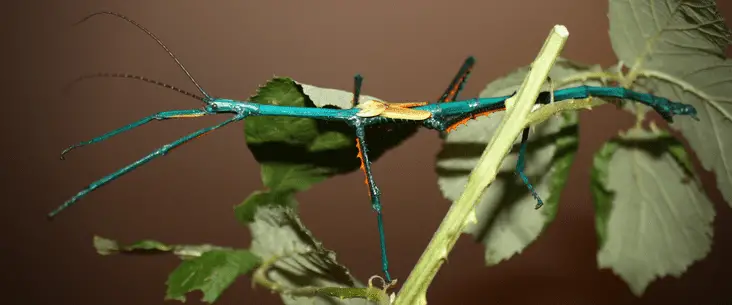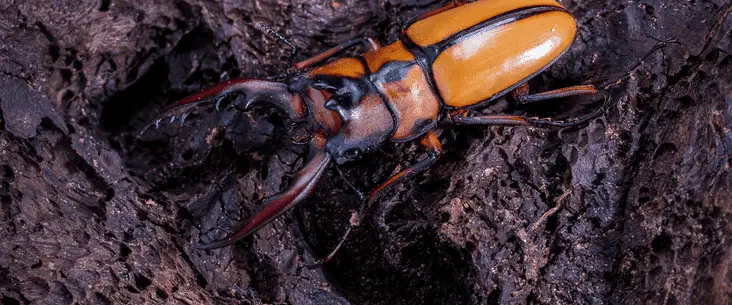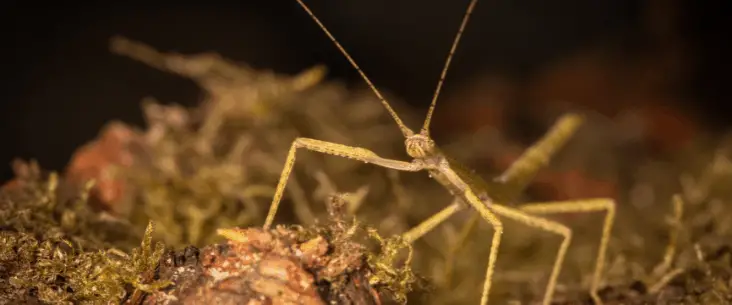Do you want to keep ivory millipedes? Or do you have them already? Ivory millipedes (Chicobolus spinigerus) are among the easiest giant millipede species to keep and are a great choice when you are a beginner. These beautiful looking millipede species are hardy and don’t have high requirements. Nonetheless, they still need good care.
They have some basic needs you need to fulfil to make them thrive. In this care guide, we will discuss all you need to know to get you started keeping ivory millipedes.
Ivory millipedes are easy millipedes to care for and are great for beginners. Although they don’t have high requirements, you still need to provide proper housing, create an optimal environment and feed them nutritious food. This care guide provides all the needed knowledge to give them the best care possible.
There is much to learn about millipede care. We will discuss housing, environmental needs, best feeding practice and how you can breed with these amazing millipede species. But first, we will have a closer look at ivory millipedes to discover more about them.
In this series of Backyard Bugs, we explore wild bugs and how you can provide a better living for them with simple things. The world population of insects and related bugs is rapidly declining. Their important role in the sustainability of life and the future of our planet is often underestimated. This series is to stimulate more and more people to be aware, to act and provide a better environment for these important creatures. We partner with companies that offer products that we think are great for you to use, and that can help you achieve your goals. If you purchase through our partner links, we get paid for the referral at no additional cost to you! Please read our disclaimer for more info.
About the ivory millipede
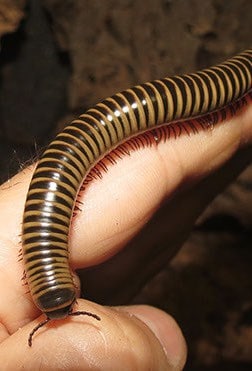
Photo by Jonathan’s Jungle Roadshow
Appearance
Ivory millipedes have a coffee-creamed colour with dark brown (almost black) bands on each segment. The legs are pinkish to dark brown. There is quite some colour variation within this species. Some are much darker than others. On each body segment, there are two pair of feet.
Generally, they grow up to 7.5cm (3″), but there are some individuals that reach up to 10cm (4″). These are mostly females, and males are typically slightly smaller between 4cm and 8.5cm (1.6″-3.3″).
On the other hand, instars are translucent white coloured and, when just hatched, barely 1cm (0.4″) in length. The older they get, the more colour and contrast they get.
Purple Ivory Millipede Morph
The purple ivory millipede is a colour morph of the more known Florida ivory millipede. They belong to the same species (Chicobolus spinigerus), and they need the same care as described in this care guide. They have beautiful purple coloured bands on each segment. However, the purple colouration will change to a beautiful black & white when they become adults.
Behaviour, temperament and handling
What makes these giant millipedes so popular as pets is that they are ‘surface-active’. These millipedes show themselves much more than other millipede species do. It is amusing to see the many legs waving over the ground, slowly push its long body forwards. They are calm pets that just enjoy their own daily business.
You can house these millipedes in groups. The size of the enclosure depends on how many millipedes you want to keep. They don’t bother each other and can happily live side-by-side. You can only get problems when the enclosure gets overcrowded or if there isn’t enough food.
Millipedes make great pets because they are not dangerous. They don’t attack, bite, sting or injure humans in any way. The only notice is that they can secrete a brown fluid when feeling threatened. This fluid can irritate the skin, especially when you are allergic to it. It also can make stains on your skin or clothes. Always wash your hands afterwards. You can also use non-powdered latex gloves or a spoon to handle them or move them.
Although ivory millipedes are quite docile and can be handled carefully, they don’t necessarily like to be touched, petted or handled. They are quite hardy animals, but still don’t handle them too often.
If you like to achieve breeding with giant millipedes, this is the best species to begin with. They are easy and quick breeders. You don’t have to do much to it to see baby millipedes emerge. You can find more on this subject in the breeding section below.
New to keeping giant millipedes?
Are you new to keeping giant millipedes? Millipedes are great pets, but it is important to know the basics before keeping them. I recommend you to read our basics guide on how to keep and care for millipedes. It contains all the needed information and is packed with practical tips.
Housing requirements for ivory millipedes
It all starts with good housing. Although these species doesn’t require that much space, they still need proper sized housing. There are also some features that your enclosure must have. All this is discussed in the section below.
Type and size of the enclosure
Ivory millipedes are quite easy to house. Because these animals are floor dwelling species, the floor space is more important than the height. For the size, we recommend that you have an enclosure at least 3 times the adult body length in width and 2 times the body length in depth. That makes a minimum size for adult ivory millipedes of 30cm x 20cm (12″ x 8″).
You can house them individually or in groups. If you like to keep more animals, you also need a larger enclosure. A 60cm x 45cm (24″ x 18″) is enough to keep a group up to 10 millipedes. Keep in mind that they easily breed and you can soon have many more millipedes.
The enclosure needs to be at least 1 time the body length in height, although it is easier to have an enclosure that is a bit higher. It makes it easier to take care of them, and you must be aware they also need a thick layer of a substrate.
There are different enclosures of different brands available. Exo Terra and REPTIZOO have some great terrariums that are very good to house millipedes. But they are also more pricy as well. An alternative is to use an old aquarium with a custom made lid. You could also use a plastic container box and adapt it to make it suitable for millipedes. But the problem with plastic is that it decreases the visibility. In a glass terrarium (or aquarium) you just can see your animals better.
My personal favourite is the Exo Terra Large/Low (PT2611) enclosure with a size of 90cm x 45cm x 30cm (36″ x 18″ x 12″). It has a large floor space and all the features necessary to keep a group of giant millipedes properly.
Terrariums that are suitable for millipedes
Essential features of the enclosure
Whatever enclosure type you choose, they must have some essential features crucial to keep millipedes healthy and alive.
- Ventilation — The most crucial feature an enclosure needs to have is enough ventilation. Millipedes are kept in (semi)humid environments, and without ventilation, the soil gets soak and mouldy. Terrariums generally have enough ventilation (mesh lid and ventilation holes in the front panel). With an aquarium or a plastic container, the lid needs to be adjusted to have proper ventilation.
- A lid — We already mentioned it, but a lid is a must. Without a lid, your millipedes will climb out in no time. But make sure that with the lid on the enclosure has enough ventilation.
- Waterproof bottom — The floor needs to be waterproof. As discussed later on, you need to add a thick layer of a substrate that will contain moist. Not only seeps water out what is pretty annoying, but it also dries out your substrate too fast. Net cages are therefore not suitable as an enclosure for millipedes.
- Easy access — To make caring for them easy, you need easy access to the enclosure. Preferably, the lid is removable to spray water into the enclosure easily and to be able to redecorate and refresh the substrate.
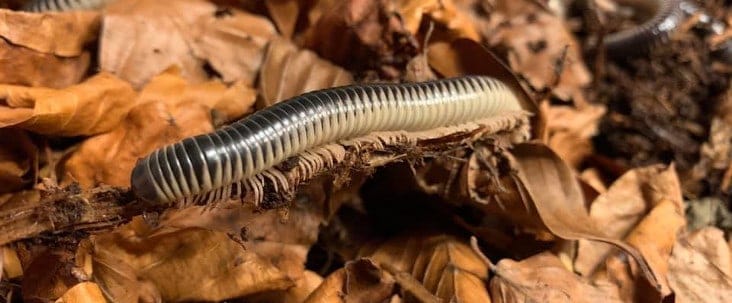
The substrate for ivory millipedes
One thing that is important to understand when keeping millipedes: The substrate is life for millipedes. They will never get old and stay healthy without a good layer of a quality substrate.
The substrate needs to be at least 5cm (2″) thick, but I recommend to place 10cm (4″) or even more substrate in it. Substrate consist of two parts: A base component (filler) and the food component.
The base component is used to create volume so that you have enough substrate to fill the enclosure. One of the best products to use as a base component is coconut fibre. This product is cheap, clean, lightweight and consistent in structure. Coconut fibre — also called coco fibre, coil fibre and eco earth — is also perfect for maintaining the humidity level when keeping moist. Other products that also can be used are potting soil, topsoil, and organic compost. In my experience coconut fibre works best.
The second part is the food component. This part is essential when keeping millipedes (don’t underestimate it!). Millipedes are detritivores. In other words, they live from decaying organic matter. To provide this for your millipede, you should add decaying leaves and decaying wood (flakes) to your substrate. Make sure you only use leaves and wood from hardwood tree species (e.g. oak, beech, birch, etc.).
Recommended read: Millipede substrate guide!
There is much to know about the substrate for millipedes. Because the substrate is so important for millipedes to keep them healthy and alive, we wrote a guide about the substrate for millipedes. It is packed with practical tips and things you should know about it. I invite you to read it.
Environmental condition to keep ivory millipedes
Ivory millipedes don’t have high climate requirements, but they naturally live in another climate than your living room. You need to provide them with the proper environmental conditions so they feel happy and can thrive. It is important to optimize the temperature and humidity for your animal.
Temperature and heating
Ivory millipedes are best kept at a temperature between 22°C and 26°C (72°F-78°F). Room temperature is not bad for them, but they just do better when it is a bit warmer. So, additional heating is necessary. Just place some low wattage light bulbs (25W) above your enclosure, or use a low wattage heating pad. Try to avoid higher temperatures. This will quickly dry out the substrate and habitat.
Always place the heating source outside the enclosure. A light bulb should be at least 1cm (0.4″) away from the lid. A heating pad is placed below the enclosure, but can also be taped on the backside of the enclosure.
It is not a problem for the night that the temperature drops below 22°C (72°F). Try not to lower temperature below 15°C (59°F). If you live in a place where night temperatures drop much lower, you should use a heating pad for the night to keep it around 15°C (59°F). Don’t use a light bulb for the night. Millipedes also need some dark hours.
Lighting and lightcycle
Ivory millipedes need a normal day/night cycle. Not that these species directly like/need light, but they need a natural biorhythm. Never place the enclosure in direct sunlight. An enclosed space will heat up quickly by the sunlight up to temperatures that are deathly to your millipedes.
You don’t have to provide additional UVB light. There is no evidence they need it, and in nature, you don’t see them sunbathing like reptiles do, for example.
Humidity and spraying
It would be best if you kept these millipedes moist at all time. They need a moist substrate to stay healthy and happy. It is not the humidity in the enclosure that counts, but the moisture in the substrate they love and need. You can mist-spray water onto the substrate regularly. Between spraying, let the top layer of the substrate dry.
How frequent you’ll need to spray depends on many factors, such as ventilation and airflow, ambient humidity and the effect of your heating source. Be careful not to spray too much water and make the substrate soaking wet. Spraying frequency will range between daily and once a week.
A moist substrate is also important for the newly hatched millipedes and eggs. They won’t survive when you let the substrate dry out, and survivability drops when you don’t keep them moist enough.
These millipedes don’t need a drinking bowl. They drink the moisture in the substrate, and the little water drops on the glass, plants, moss or other objects in the enclosure. A drinking bowl can cause newly hatched millipedes to drown.
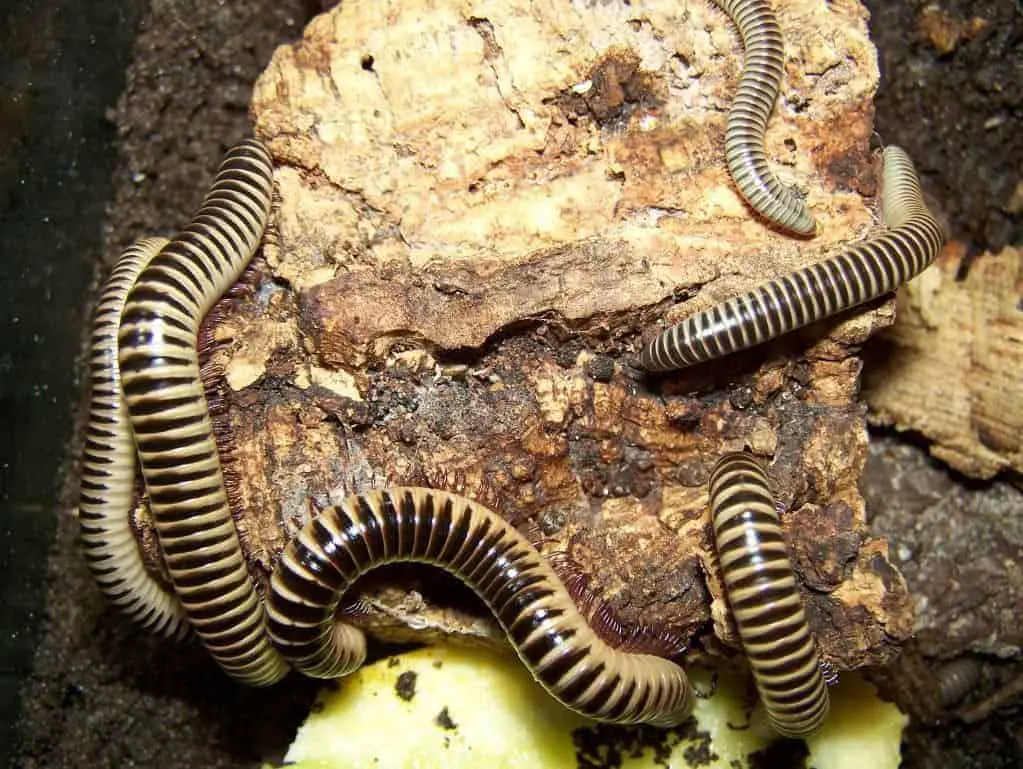
Feeding your ivory millipede
Millipedes can survive solely on a good quality substrate. In fact, without good substrate, they won’t stay healthy. But, it is good practice to feed them supplemental food items as well for extra nutrients (e.g. minerals and vitamins).
They tend to grow faster and better reproduce when you feed them vegetables, fruits and powdered food. And it is also much fun to see them nibble on these food pieces.
Supplemental food items
Products that you can feed include:
- Fruits such as watermelon, cantaloupe, apples, pears, oranges and pumpkin.
- Vegetables such as cucumber, endive, chicory, carrots, celery and tomatoes.
- Dry dog or cat food pellets, or fish pellets.
- Powdered food such as powdered milk, baby powder formula and powdered calcium supplement or crushed up cuttlefish bones.
They do not favour all products. Some products won’t be accepted because they simply don’t like it. The products mentioned above are food items that I have seen acceptance feeding them. But, you can also add dried crumbled leaves, oak leaf flakes and flake soil to it.
Method, amount and frequency of feeding
Most products can just be placed on the substrate. Fruits, vegetables, dried leaves, flake soil: There is no need to place them in a food bowl. If you feed all these products in a food bowl, smaller animals (also hatchlings) which are burrowed more often can’t eat from it. When placing it on the substrate, they can reach it as well from below.
Other products can be sprinkled on the substrate as well, but I like it to feed pellets in a food bowl for two reasons. First, when you spray the enclosure water will accumulate in the food bowl, soaking the pellets and make them easier to eat for the millipedes. With this method, the pellets contain enough water to hydrate the millipedes too. And second, you can easier clean and refresh the pellets and keep the substrate clean. Pellets, especially when wet, tend to get mouldy pretty quick. You don’t want mould all spread into your substrate, do you?
How much a millipede feed is difficult to say and depends on how many millipedes live in the enclosure, the sex and in which life stage (or age) they are. Just feed them and observe how they eat. If the supplemental food is eaten in a short time, you can feed them more. If you find a lot of leftovers after two days, you probably should feed less.
Powdered food should not be fed too often. If you feed powdered food once every month is often more than enough. The best way is to sprinkle some powder on the substrate and spray water on it to make it sink into the substrate.
Cleaning routine
Cleaning of millipede enclosure is so easy because there is almost nothing to clean. Actually, the only thing you need to do regularly is to remove uneaten food items after at least 3 days and at that moment do some spot cleaning when you see dirt. When some mould develops just spot clean that section of the substrate. That’s it!
But when do you clean the substrate as a whole? Well, you should at least refresh the substrate when you see large quantities of faecal pellets emerge on the surface of your substrate. This needs to be done once every three up to twelve months, depending on how many species there are in the enclosure.
Funny enough, you shouldn’t clean the substrate too often. Every time you dig into the substrate, you disturb burrowed millipedes or eggs. Too often and too much disturbance will harm your millipedes. This is especially true for millipedes that just have moulted or that just hatched.
You can also make a bioactive setup using a clean-up crew. However, and this is an important one, preferably only use springtails as a clean-up crew. Where springtails eat solely on fungi and bacteria, isopods also feed on the decaying organic matter, which is the primary food source for your millipedes. With other words, the isopods will compete for food with the millipedes. In the long run, isopods can overrun the enclosure, which is stressful for the millipedes.
Caution! Be careful with the use of any soap or chemicals to clean the enclosure. Anthropods, where millipedes belong to, can’t handle household cleaning chemicals. When using this soap, can sooner or later kill your millipede. Try to clean the enclosure only by using water.
When soap is needed, remove the millipede and place them in a temporary enclosure. Make sure afterwards you rinse the soap residue thoroughly with water.
Ivory millipede breeding: practical tips
Ivory millipedes are easy breeders and one of the quickest compared to other giant millipedes. That is because they are already sexually mature after 18 months.
Besides that, females lay around 300 eggs and with a survival rate of 90 % (in case of proper care and properly fed) you will soon have many baby millipedes. If you like to achieve breeding with giant millipedes, this is probably the best species to begin with. Breeding with a millipede species is amazing to achieve.
However, there are some things that you need to consider to have a better breeding result. No bug species will breed (or will the offspring survive) in non-optimal conditions.
How to stimulate breeding
Ivory millipedes are one of the easiest millipedes to breed. When you have both genders, both are sexually mature (which they are already after 18 months), and you take care for them as we recommend you in this practical care guide, you likely will find young ivory millipedes soon. However, there are some things you could do to stimulate breeding even more.
- The substrate should be of good quality, consist of fine material (like coconut fibre) and contain enough decaying organic material as food.
- The substrate needs to have a minimum depth of 10cm (4″), but more would be better (around 15cm/6″). A shallow substrate may prevent the laying of eggs.
- The substrate needs to be pretty damp (however not soaking wet). A too dry substrate prevents females from laying eggs and/or laid eggs will die off because of dehydration.
- You can add an additional layer or rotten leaves on top of the substrate. Please don’t mix it in the substrate, because this will disturb the millipedes that are burrowed, moulted or the possible eggs/newly hatched millipedes already in the substrate.
Additional read
If you like to know more about the basics of keeping giant millipedes then read our basics guide for keeping millipedes.
Do you wonder how much it costs to keep millipedes? Not just how much it is to purchase a millipede, but all the costs you probably need to make for keeping millipedes. We have documented all the costs in this millipede initial and yearly cost breakdown.
Share this page!

